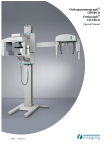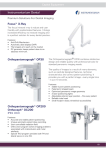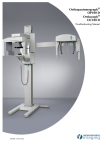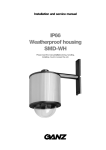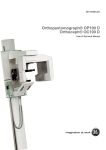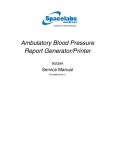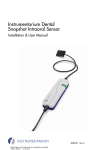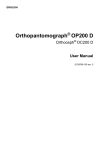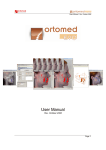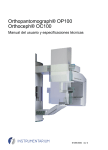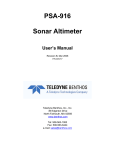Download Orthopantomograph OP100 Orthoceph OC100
Transcript
Orthopantomograph® OP100 Orthoceph® OC100 Ortho ID Installation & User Manual 03/2003 63300 Copyright © 2003 by Instrumentarium Imaging Documentation, trademark and the software are copyrighted with all rights reserved. Under the copyright laws the documentation may not be copied, photocopied, reproduced, translated, or reduced to any electronic medium or machine readable form in whole or part, without the prior written permission of Instrumentarium Imaging. Orthopantomograph® and Orthoceph® are registered trademarks of Instrumentarium Corporation. U.S. patents 4,641,336; 5,016,264; 5,425,065 and 5,444,754. German patent 4,344,745. Orthopantomograph® OP100 and Orthoceph® OC100 comply with UL and C-UL (File E157261). The original language of this manual is English. Instrumentarium Imaging reserves the right to revise this publication from time to time and to make changes in the content of it without obligation to notify any person of such revision or changes. Manufactured by Instrumentarium Imaging P.O. Box 20 FIN-04301 Tuusula FINLAND Tel. +358 10 394 6500 Fax. +358 10 394 6501 E-mail: [email protected] Internet: http://www.InstrumentariumImaging.com Table of Contents 1 2 3 Introduction ........................................................................................................ 1 Installation........................................................................................................... 3 OP100 modifications........................................................................................... 5 3.1 3.2 4 Printer controls ................................................................................................... 7 4.1 4.2 4.3 4.4 5 6 7 Display..................................................................................................................... 7 Rear panel ................................................................................................................ 7 Keyboard ................................................................................................................. 8 Principle of the operation ........................................................................................ 9 Getting ready..................................................................................................... 11 Entering the patient data ................................................................................. 13 Printing .............................................................................................................. 15 7.1 7.2 7.3 7.4 8 CPU Board cabling.................................................................................................. 5 Software update ....................................................................................................... 6 Printing the patient data......................................................................................... 15 Printing the same patient data again ...................................................................... 16 Printing the same patient data & technique factors again ..................................... 17 Printing the qa film data ........................................................................................ 17 Special functions ............................................................................................... 19 8.1 Patient data file ...................................................................................................... 19 8.1.1 8.1.2 8.1.3 8.1.4 8.2 9 Enter new patient .....................................................................................................19 Select pre-entered patient.........................................................................................20 Deleting a pre-entered patient from the data file .....................................................21 Select the clinic / dentist name for printing .............................................................21 Setup menu ............................................................................................................ 22 Trouble shooting ............................................................................................... 23 63300-4AB Instrumentarium Imaging i ii Instrumentarium Imaging 63300-4AB 1 Introduction 1 Introduction Ortho ID is a desk top equipment for printing the patient data and exposure data received from the OP100 on an x-ray film. A window type film cassette is used. The Ortho ID can be used with all OP100 and OC100 models. Some older models require the upgrading (option code 61260). This manual covers the features of the software versions V 1.01 or higher. The following markings and symbols may have been used in this manual: NOTE Contains useful information for the reader about the unit and its use. CAUTION Contains important instructions. If these instructions are not observed, malfunction of the unit or damage to the unit or other property may occur. WARNING Contains warnings and instructions about the safety of the unit. if these warnings are not respected, serious risks and injury may be caused to the patient and operator. Attention, consult accompanying documents. If the unit has CE - marking it is CE-marked according to the Medical Device Directive 93/42/EEC. Radiographic control. 63300-4AB Instrumentarium Imaging 1 1 Introduction 2 Instrumentarium Imaging 63300-4AB 2 Installation 2 Installation 1 Open the box. Lift the Ortho ID from the box and place it on the table top. Remove the end pieces. 2 Locate the accessories: OP100 Interface cable or Interface cable CE, Installation & User Manual and Technical Manual. Cassettes may have been included in this shipment 3 Additional accessories may have been packed for upgrading the OP100 for the Ortho ID. 4 witch the OP100 power off. Connect the interface cable between the Ortho ID and OP100. The OP100 and Ortho ID can be used in the same room or in separate rooms. 5 Switch the OP100 power on. Ortho ID displays its software version and the language version (A or B). If nothing is displayed, check the OP100 and cabling. See the section 3 OP100 Modifications. 6 Configure the Ortho ID for daily use. Refer to the Ortho ID Technical Manual, Section Setup. Fig 2.1. Connecting the OP100 Interface cable. CE model is similar. 63300-4AB Instrumentarium Imaging 3 2 Installation 4 Instrumentarium Imaging 63300-4AB 3 OP100 modifications 3 OP100 modifications Ortho ID requires the OP100 software version 1.2.05 or higher and proper cabling from the CPU board to the X 106 connector. 3.1 CPU Board cabling Modifications to the OP100 CPU board are required for the following units: s/n 70000-70626, 70630, 70639-70680, 70682-70683 and 70688-70700 1 Switch the OP100 power off. Remove the mirror cover and carriage lower trim cover. 2 Check the OP100 cabling. Check, if there is additional wiring from the serial interface connector X106 (pins 6 & 8) to the CPU board. X106 is located in the carriage lower cover. 3 If not, add a special cable between the CPU connector X 12 and X 106. Connect the black wire (GND) to the X 106 pin 6 and the other (+25V) to the pin 8. Connect the other end to the CPU X12. CPU X12 X106 9 5 8 yellow 4 7 3 6 black 2 1 X106 63300-4AB Instrumentarium Imaging 5 3 OP100 modifications 3.2 Software update Modifications to the OP100 CPU board have been done at the factory for the following units: s/n 70627-70629, 70631-70638, 70681, 70684-70687 and all units from s/n 70701 However, all OP100 units must have the correct software version to operate with the Ortho ID. 1 Switch the OP100 power off. Remove the mirror cover and carriage lower trim cover. 2 Check the CPU program versions. Ortho ID does not work with the OP100 program version numbers below: ICD 29 User Program version 1.2.01 ICD 28 Service Program version 1.2.01 ICD 25 PAL circuit version 1.0.0 3 Record the following programmed values from the User Programs “Pr 50 PrS” and “Pr 52 CCo” and Service Programs “Sr 73 AEC” and “Sr 89 rEo”. They may have to be reprogrammed. Refer to the OP100 Manuals. 4 If the OP100 has older versions, replace them with ICD 29 User Program version 1.2.05 or higher ICD 28 Service Program version 1.2.05 or higher ICD 25 PAL circuit version 1.1.0 or higher 5 Replace one circuit at time to avoid the mixing of circuits. Note the circuit orientation on the CPUboard 6 Connect the interface cable, if not in place. Switch the OP100 power on. Ortho ID displays its software version and it is ready for printing. 7 The preprogrammed technique factors and AEC parameters must be changed. V1.2.05 & V1.2.06: reprogram “Pr 50 PRS” to match with the longer exposure time in the OP100 Programs 1 to 4 and 6 to 10. Set the “Pr 52 CCO” to a new value, if preferred. V1.2.07 or higher: set the “Pr 52 CCO” contrast level and density per User Program Manual (code 63328). 8 Set the “Sr 73 AEC” value one step lower to match with the longer exposure time. “Sr 89 rEo” has new features. Set the Remote exposure, Ceph Collimator, AEC and Free Exposure Selections as wanted, “OFF” or “on”. Set the OP100 CPU for the User Mode (X10). 9 Replace the covers. 6 Instrumentarium Imaging 63300-4AB 4 Printer controls 4 Printer controls 1 Keyboard 2 Display 4 x 20 characters 3 Printing slot 4 Cassette 4 2 3 1 4.1 Display Clinic Data (13 or 11 characters) Date (6 or 8 characters) OP100 Exposure Data (20 characters) Patient Data (2 x 20 characters) 4.2 Rear panel 1 Slot for the OP100 interface cable 2 OP100 Interface cable or OP100 Interface 1 cable CE 3 Main label (in the bottom) OP100 2 3 63300-4AB Instrumentarium Imaging 7 4 Printer controls 4.3 Keyboard The keyboard is available in one universal layout. Special letters are available by pressing two keys. OP100 style keys: ↑, ↓, ←, →, OK are used. A - Z, a - z Alphanumeric keys, upper & lower case: 0 - 9 Numbers Special keys: MENU. Enter for / exit from patient data file menu OK. Select function / accept a choice. UP. Previous entry line or function or show last patient’s data on the display. DOWN. Next entry line or function. LEFT RIGHT Move the cursor on the entry line or select previous / next programmable feature SHIFT together with a letter displays an upper case letter or character CLEAR. Empty the entry field and exit from the editing. BACKSPACE. Move the cursor to the left and delete the last character. SHIFT, BACKSPACE. Display the last printed patient data with the technique factors. 8 Instrumentarium Imaging 63300-4AB 4 Printer controls CAPS LOCK. Upper case letters. ENTER. Move the cursor one row down. Language dependant keys can be selected either by pressing the key, eg. Ü or by first pressing the special key and then the letter (eg. to have ë press “ and then press e ): English: A - Z, a - z, ñ German: A - Z, a - z, ß, Ü, ü, Ä, ä, Ö, ö, ñ French: A - Z, a - z, ç, é, ê, è, à, ë, Ä, ä, Ö, ö Italian: A - Z, a - z, é, à, ì, ò, ü, ä, ö Spanish: A - Z, a - z, á, é, í, ó, ú, ñ, ü, ä, ö Finnish: A - Z, a - z, å, ä, ö Swedish: A - Z, a - z, å, ä, ö 4.4 Principle of the operation Inputs Selection / Prosession OP100 Ortho ID Outputs Printed label Dental clinic+date Exposure data Setup Error data Language Exposure data Date format Date & time Patient data Print time Dentists Service: - print contrast Power +25V Patient data - display contrast - serial interface Displays Keyboard Data management 1. Select patient Ortho ID's integrated 2. Enter new patient Normal display 4 x 20 3. Select dentist keyboard Print display Last patient & Technique factors 4 x 20 The Ortho ID is a microprocessor controlled equipment. It receives the exposure data and power form the OP100 via a cable. The keyboard is used to enter the patient data and for selecting different functions and the display (Normal display) shows the dentist name, date, OP100 exposure data and patient data for printing. The same data is on the print display (inside the Ortho ID) from where it is transferred to the film when the cassette has been pressed and the OK key is pressed. The Setup program is used to configure the Ortho ID for daily use. This is usual done at the installation. The Data Management program is used for entering the coming patients into the memory, from where the patient data can be recalled in that order the patients are printed. The printed patient data goes into the History file. Last patient with technique factors can be recalled and last 10 patients’ names without technique factors can be recalled. 63300-4AB Instrumentarium Imaging 9 4 Printer controls 10 Instrumentarium Imaging 63300-4AB 5 Getting ready 5 Getting ready 1 Switch the OP100 power on. Ortho ID displays its software version for few seconds and beeps. 2 The Normal display is shown. First row shows the clinic or dentist name, eg. CLINIC DATA, if pre-entered, and the date. The cursor is blinking on the third row. 3 Ortho ID is ready to receive technique factors’ information. If the OP100 has not sent the technique factors, the display looks similar to the example above. 4 Make the exposure with OP100. Data is sent to Ortho ID automatically and displayed. For Standard panoramic program #1 the display may look like this: 12345 Exposure count 1 Standard Panoramic Program #1 A Automatic Exposure Control 77/6.4 kV/mA D2 AEC Density setting in center position (D0 = left, D4 = right) For the OC100 Cephalometric program #5 the display may look like this: 12345 Number of exposure 5 Cephalometric Program #5 77/12/0.64 kV/mA/s 63300-4AB Instrumentarium Imaging 11 5 Getting ready 12 Instrumentarium Imaging 63300-4AB 6 Entering the patient data 6 Entering the patient data The user can pre-enter up to 100 patients’ data, two rows of 20 characters, and later recall them from the memory for printing. The user can also select the dentist’s name for each patient before printing. 63300-4AB 1 The Normal display: the first row shows the dentist or clinic name and the date. The cursor is blinking on the third row. 2 If you want to change the dentist’s name for this patient, press the menu key. Follow the instructions on the display or refer to the Section 6 Special Functions. 3 Enter the patient data for the two last rows, maximum 40 characters. Press “ENTER” at the end of the text to move to the last row. 4 Eg. type in “John Smith” and press “Enter”. The cursor moves to the last row. 5 Type in additional patient data, eg. “12345678-ABCD”. A maximum of 20 characters can be entered, a long beep will be heard at last character of the line. 6 Ortho ID is ready for printing the patient data. The patient data may be entered before or after the OP100 exposure. Instrumentarium Imaging 13 6 Entering the patient data 14 Instrumentarium Imaging 63300-4AB 7 Printing 7 Printing 7.1 Printing the patient data 1 Make sure that the patient data you want to print is on the display. 2 Insert the cassette into the printer slot, the window side at the right lower corner, facing the operator. NOTE To assure the cassette window opening, make sure the cassette is placed against the right side of the cassette holder. 63300-4AB 3 Check that the technique factors information is on the display. 4 Press the cassette down. A message is displayed. Instrumentarium Imaging 15 7 Printing 5 Hold the cassette down and press the ok key. Display shows “PRINTING” and a beep is heard. The printing window of the cassette is automatically opened and the printer will expose the data on the film. 6 After the printing two beeps are heard and the display shows momentarily “READY”. NOTE If the cassette is released too soon, printed data may be lost. 7 Lift the cassette. The patient data is stored into the memory and it disappears from the display. 8 Process the film. The printed data will be shown on the film. Note the orientation in reference to “L” and “R” on the film. 7.2 Printing the same patient data again 1 Ortho ID stores the last 10 patients’ data in the memory. This data can be recalled for the printing. 2 Assume you have printed the patient “JOHN SMITH” data. Ortho ID is ready for the next patient. 3 Press the up key. One or two rows of the last patient’s data is displayed. The cursor is blinking on the third row. 4 Press up or down key to view other patient’s data to be displayed and press the ok key to select. The patient data is displayed. 16 Instrumentarium Imaging 63300-4AB 7 Printing 5 7.3 Make the exposure. Print the data. Process the film. Printing the same patient data & technique factors again 1 Ortho ID stores the last patient’s data and the matching OP100 technique factors. This information can be recalled for printing. It can be used for testing or for duplicating purposes. 2 Ortho ID is ready for the next patient. Assume you have printed the patient “JOHN SMITH” data. 3 Press shift and bacspace simultaneously. Last patient’s data with OP100 technique factors is displayed. 4 Press shift and backspace keys or any other key to resume to the Normal display, if you do not want this feature. 5 Print the data. Process the film. 7.4 1 Printing the qa film data Make the QA exposure. Technique factors will show on the display, where: “0” QA program “85/8.0” last kV/mA values used 63300-4AB 2 Enter for the last two rows any additional information for filing purposes. 3 Print the data. Process the film. Instrumentarium Imaging 17 7 Printing 18 Instrumentarium Imaging 63300-4AB 8 Special functions 8 Special functions The Ortho ID has special features for the patient data filing (DATA MANAGEMENT) and for configuring the Ortho ID for daily use (SETUP). Patient data is stored in the memory from where it can be retrieved. This allows the pre-entry of the patient data. The Setup program allows the user to configure the Ortho ID for best performance. Such features are the Language version, the Date format and setting, the Dentist names for the practice and the Print time setting. 8.1 Patient data file The Data Management has three functions: • • • new patient data can be entered, patient can be retrieved from the file and clinic or dentist names can be entered. 8.1.1 63300-4AB Enter new patient 1 While in the Normal display press “MENU” key. The Data Management screen is displayed. 2 Press “2” or move the cursor down over the third line and press “OK”. 3 Enter the patient data into the last two rows. Begin with a letter or number. 4 Type in eg. “Juliet Smith and press enter. Type in 1122334455 XYZ”. Press “OK”. 5 Data will be saved and the display shows a message. Instrumentarium Imaging 19 8 Special functions 6 Repeat steps 3 to 5 for other patients. 7 Exit by pressing “OK” before entering more patient data: do step “2” instead of step “1”. The Normal display is shown. NOTE If you press MENU before saving the patient data entry with OK, the last patient data is not saved. 8 An error message is displayed, if the data file has already 100 patients and a new one is entered and saving is tried. This patient’s data is not saved. 8.1.2 Select pre-entered patient 1 Press the “MENU” key while in the Normal display. 2 The Data Management screen is displayed. The cursor is blinking at “1”. Press “1” or press “OK”. 3 First patient data in alphabetic order is displayed. Use arrow keys or press letters A to Z to review the patient data file. Example: Pressing “B” will display the first name starting with “B....”. Pressing M will display the first name starting “M...” etc. If the data file does not have names starting with those letters, another name beginning with “A...” or “L...” is displayed. Names beginning with any other characters than A to Z are at the end of the data file after Z. 4 Press the OK key to select the patient to be printed. The Normal display shows the patient data. 5 An error message is displayed, if there are no patients in the data file. 6 Press the OK key to clear the message. The Normal display is shown. 20 Instrumentarium Imaging 63300-4AB 8 Special functions 8.1.3 Deleting a pre-entered patient from the data file 1 While in the Normal display press “MENU” key. The data management screen is displayed. 2 You can delete the patient’s data from the file. Find the patient data you want to delete. 3 Press CLEAR. The program will ask you to confirm and a beep is heard. 4 Press OK to delete this patient’s data or any other key to resume to the patient selection menu. NOTE To clear the complete patient data file, press SHIFT and CLEAR. Use with caution - all pre-entered patient data will be lost. The program will ask you to confirm and a beep is heard. Press OK to delete the data file or any other key to resume to the patient selection menu. 8.1.4 63300-4AB Select the clinic / dentist name for printing 1 While in the Normal display press the “MENU” key. The Data management screen is displayed. 2 Press “3” or move the cursor over the third line and press “OK”. The current Clinic / Dentist selection is displayed. 3 Up to ten names may have been programmed for the clinic / dentist names. Use up and down keys or press 0 to 9 to search for the name, eg. Dr Miller. Instrumentarium Imaging 21 8 Special functions NOTE The dentist name is only called from the memory. To change any name, refer to the Setup. 4 Press OK. The selection is stored and the Ortho ID resumes to the Normal display. The new clinic / dentist name is displayed. 8.2 Setup menu The following parameters can be programmed. Please refer to the Ortho ID Technical Manual for details: ORTHO ID SETUP Feature Options Dialogue language version A (ROM A) English, German, French, Spanish, Italian Dialogue language version B (ROM B) English, Finnish, Swedish Date format YYMMDD, MMDDYY, DDMMYY, MM/DD/YY Date and time setting YY, MM, DD, hh, mm, ss Clinic data 1 to 10 dentist names, each max. 13 characters Print time (s) 0.10, 0.12, 0.16, 0.20, 0.32, 0.40, 0.50, 0.64, 0.80, 1.00, 1.20, 1.60, 2.00, 2.50, 3.20, 4.00, 5.00, 6.40 Service Printing contrast, Display contrast, Serial Transfer Test 22 Instrumentarium Imaging 63300-4AB 9 Trouble shooting 9 Trouble shooting PROBLEM 63300-4AB CAUSE REMEDY No information on the display. – A problem with the cabling – OP100 power off – Check the wiring between the OP100 and Ortho ID – Installation: check that X 106 has +25V voltage wiring – Switch the OP100 power on Ortho ID data displayed, but no OP100 technique factors information on the display. – A problem with the cabling – OP100 software version 1.2.01 used – OP100 exposure not yet started – Check the wiring between the OP100 and Ortho ID – Installation: replace the software – Make the exposure No printed data on the film. – The cassette misplaced – The cassette window has not opened – The cassette not placed against the right side of the cassette holder while printing – Printing time is too short – The OK key not pressed while holding the cassette – Check the cassette orientation- Push the cassette to the right when printing – Check the printing time – Press OK Printed data too pale or lack of contrast. – Printing time too shor – Printing contrast is not optimal – Wrong film type, eg. blue sensitiv – The cassette lifted too soon – Check and adjust the printing time – Check and adjust the printing contrastCheck the film – Keep the cassette pressed from “PRINTING” to “READY” Printed data too dark. – Printing time too long – A cassette light leak – Strong light above the Ortho ID Check the printing time Check the cassette Remove the light Instrumentarium Imaging 23 9 Trouble shooting PROBLEM CAUSE REMEDY Patient data was not printed, but the technique factors were. – No patient data on the display before printing – Second printing of the same patient without patient data – A problem with the Ortho ID – Enter the data before printing – Retrieve the patient data from the memory before printing – Call Service Poor display contrast. – Wrong display contrast setting – Adjust the display contrast, refer to the Setup The dialogue language is not correct or not available. – Different language selected – Wrong language option – Select a new language – Replace with another language option module Ch, Sy or Er failure message on the display. – Ch = OP100 user mistake – Sy, Er = A problem in the OP100 operation – Follow the instructions on the display, press -> – Make the corrective action 24 Instrumentarium Imaging 63300-4AB Instrumentarium Imaging Inc. 300 West Edgerton Avenue, Milwaukee Wisconsin 53207, USA Tel. +1 800 558 6120, +1 414 747 1030 Fax +1 414 481 8665 [email protected] Instrumentarium Imaging France S.A.R.L. 4, Avenue des Roses 94386 Bonneuil Sur Marne Cedex, France Tel. +33 1 43 39 51 51 · Fax +33 1 43 39 75 75 [email protected] Instrumentarium Imaging Italia S.R.L. Via Cassanese, 100 20090 Segrate (MI), Italy Tel. +39 02 21 30 28 1 · Fax +39 02 21 30 28 60 [email protected] Instrumentarium Imaging is constantly improving its products and reserves the right to change these specifications without notice. www.InstrumentariumImaging.com Instrumentarium Imaging Singapore 152 Beach Road #12-03A Gateway East 189721 Singapore Tel. +65 6391 8600 · Fax +65 6396 3009 [email protected] Instrumentarium Imaging Dental GmbH P.O.Box 2044, 77680 Kehl am Rhein, Germany Tel. +49 7851 932 90 · Fax +49 7851 932 930 [email protected] Distributor: 63300 03/2003 © Instrumentarium Imaging Instrumentarium Imaging P.O.Box 20, FIN-04301 Tuusula, Finland Tel. +358 10 394 6500 · Fax +358 10 394 6501 [email protected]
































